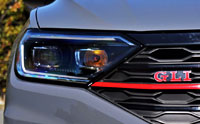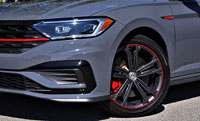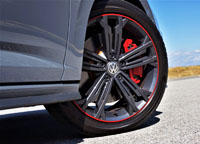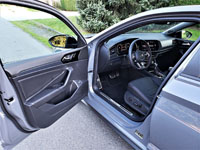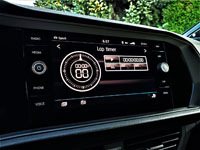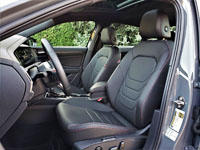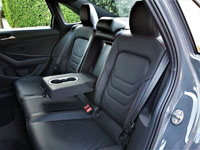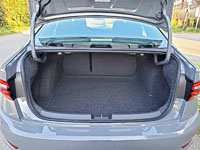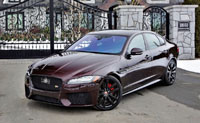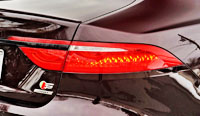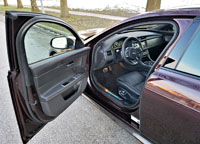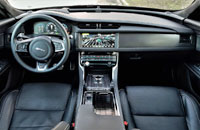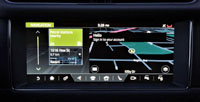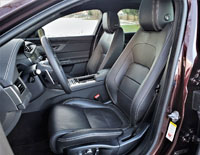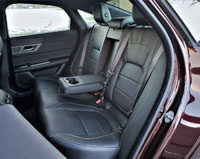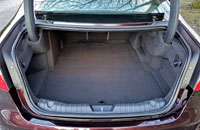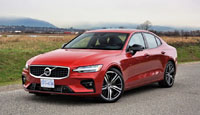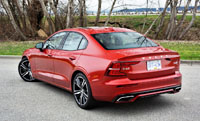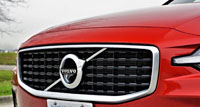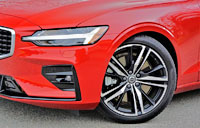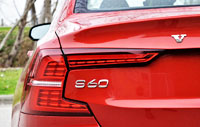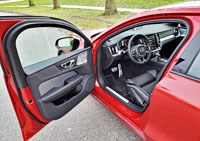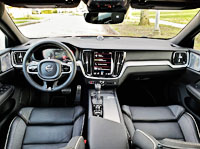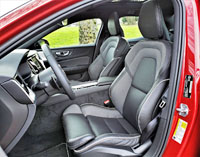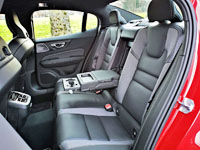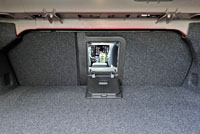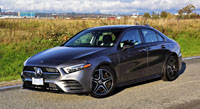
I’ve heard the line before. People only buy Mercedes-Benz products to flash its prestigious three-pointed star. That may be true in some cases, but with respect to the new A 220, and many other cars in its extensive lineup, it wins new luxury buyers by being best in class.
It doesn’t hurt that the A 220 looks as good as it does, but take note that at just $37,300 (plus freight and fees) the newest model in Mercedes’ wide and varied 2020 collection isn’t just for the affluent. Yes, that number is a significant $2,310 more than last year’s A 220, but it now comes with standard 4Matic all-wheel drive, Canadians probably not buying enough of the 2019 front-wheel drive variants to make a business case viable moving forward. Still, Mercedes’ most affordable new model is well within reach of those not normally capable of buying into the luxury class, with this base model priced very close to fully loaded versions of mainstream volume-branded compacts.
At first sight the A 220 appears too long, low and lean to be a compact four-door sedan, but with a little research I soon found out its 4,549 mm length, 1,796 mm width, 1,446 mm height and 2,729 mm wheelbase puts it slightly smaller than some mainstream compacts you likely know better, including the Honda Civic, Toyota Corolla, Hyundai Elantra and Mazda3, while it competes directly in size and particularly in price with premium-badged sedans such as the Audi A3, Acura ILX, and new BMW 2 Series Gran Coupe, although the Bimmer more accurately targets Mercedes’ sporty CLA-Class four-door coupe.
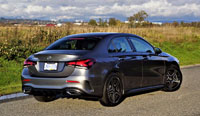
The new BMW hasn’t been around long enough to collect usable sales data, and it’s hardly been the best of years for the car industry on the whole anyway, so therefore a look back to calendar year 2019 more accurately shows the A-Class and the rest of Mercedes’ small car lineup cleaning up in Canada’s compact luxury competition. Mercedes sold more than 5,000 subcompact luxury models in 2019, which included the new A 250 hatch as well as this A 220 sedan, plus the CLA-Class and outgoing B-Class (more than 300 of the now cancelled Bs were delivered last year, and another 200-plus over Q1 of 2020).
By comparison, the second-best-selling Mini Cooper, which is also a collection of body styles and mostly lower in price, found more than 3,700 Canadian buyers, whereas the Audi A3/A3 Cabriolet/S3 garnered 3,100-plus new customers, the ILX almost 1,900, the 2 Series (ahead of the new four-door coupe arriving) at just over 1,200, and BMW’s unorthodox i3 EV finding 300 new owners. Incidentally, the A-Class, which was the only model in this segment to achieve positive year-over-year sales in 2019 (slightly below 14.5 percent), won over 3,632 new buyers last year alone, placing it just behind the previously noted Mini that saw its Y-o-Y sales fall by 17 percent.
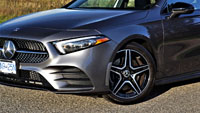
Certainly, the A 220’s attractive styling and approachable pricing contributed to its strong sales last year, but there’s a great deal more to the swoopy four-door sedan than good looks and price competitiveness. For starters is a knockout cabin that wows with style and hardly comes up short on leading-edge features. Most noticeable is Mercedes’ all-in-one digital instrument panel/infotainment display, that combines some of the most vibrantly coloured, creatively penned graphics in the industry with wonderfully functional systems, while housing it all within an ultra-wide fixed tablet-style frame.
These electronic interfaces are important differentiators when comparing an entry-level Mercedes to fully loaded compact sedans from mainstream volume brands like Honda, Toyota, Hyundai and Mazda. Truly, the A 220’s lower dash and door panels aren’t necessarily made from better materials than its more common compact counterparts, respectively the Civic, Corolla, Elantra and Mazda3, but most everything above the waste comes close to matching the tactile and materials quality found in more expensive Mercedes models, like the C-Class and even the E-Class. Together with the eye-popping digital interfaces already mentioned are gorgeous stitched leather door inserts, rich open-pore textured hardwood along those door panels and across the dash, while satin-finish aluminum trim can be found all over the interior, my personal favourite application being the gorgeous turbine-like instrument panel HVAC vents.
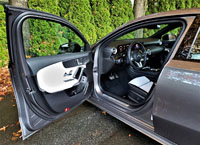
Going back to the all-in-one primary instrument cluster and infotainment widescreen display, dubbed MBUX for Mercedes-Benz User Experience, the left-side gauge package provides a number of different display themes including Modern Classic, Sport and Understated, plus the ability to create your own personalized themes, while the layout can be modified to a numeric format speedometer in place of the traditional-looking circular one, with the rest of the display area used for other features like navigation mapping, fuel economy info, regenerative braking charge info, Eco drive setting information, etcetera.
Over on the right-side of my test model’s MBUX display were the usual assortment of centre-screen infotainment functions, like navigation (albeit with the ability to opt for an augmented reality feature that shows a front camera view displaying upcoming street names and directional indicators); audio system info including graphical satellite radio station readouts; drive settings that include Eco, Comfort, Sport and Individual modes (that can also be chosen via a rocker switch on the lower console); advanced driver assistive systems settings; a calls, contacts and messages interface; a big, clear parking camera with active guidelines; plus more, and on top of all this Mercedes provides more hands-on control of infotainment functions than any competitor.

Adjustments can be made via the touchscreen itself, which is rather uncommon in the luxury class, plus you can use Mercedes’ very smart Linguatronic Voice Control system that’s easily one of the most advanced in the industry (but take note that “Mercedes” is a tad too eager to help out, always responding with a pesky “How can I help you?” when mentioning her name), or alternatively let your thumbs do the talking via a miniscule set of BlackBerry-like optical trackpads on the steering wheel spokes, or finally use the touchpad on the lower console, which is surrounded by big quick entry buttons as well. That touchpad is the best I’ve used this side of my MacBook Pro, providing intuitive responses to tap, swipe and pinch inputs, is as easy to use as dropping your right arm from the steering wheel, and didn’t cause me to divert my eyes from the road more often than necessary.
An attractive row of climate controls stretches across a smartly organized interface just below the centre display, featuring highly legible readouts and lovely knurled aluminum toggle switches, all hovering above a big rubber smartphone tray that boasts wireless charging capability. All around, the A 220 provides most everything you’ll need and a number of things you won’t, but I like the soft purple ambient lighting nonetheless.
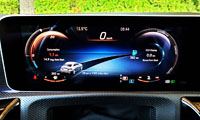
The only negative I could find were the small, delicately sized and hollow feeling steering wheel stalks for the turn signals/wipers and selecting gears, but due to how well they’re made I still can’t lambaste them completely. I’m thinking they’re more about reducing mass to save on fuel and improve performance, not that they’d individually make a big difference to either. To be clear, I’ve never tested lighter or less substantive column stalks ever. In fact, the shift paddles feel heftier, but they certainly did what they needed to and won’t likely fall apart, it was just a strange decision for Mercedes to make such important hand/machine interfaces so flimsy feeling.
Even before I shifted the A 220 into gear, I was shocked at how thin the lower door panel composite was. Was this due to weight savings as well? The plastic extrusions were perfect with thin ribs strengthening their upper edges, so it wasn’t a case of cutting corners, but they didn’t feel up to Mercedes’ usual high-quality standards. Fortunately, as noted earlier, the A 220’s more visible surfaces are superb, other than the hard-composite lower centre console that might be somewhat disappointing to those that have recently spent time in one of the upper trims of the volume-branded compacts noted before, which mostly finish such areas in soft padded pleather.

Up above is a particularly nice overhead console featuring controls for a big panoramic glass sunroof, plus LED dome and reading lights, and more. It was strange that the B and C pillars weren’t wrapped in fabric, with only the A pillars done out to premium standards, just like the mainstream cars just mentioned, but of course this isn’t totally uncommon in the luxury segment’s most basic entry-level category. At least all of components fit nicely together, with each lid and every door shutting with firm Teutonic solidity, except for the glove box lid that was particularly light in weight.
My tester’s interior was doused in a light grey and black two-tone motif, much of the grey being leather that covers both rows of seats that are wonderfully comfortable and wholly supportive, particularly via their side bolstering. They even included manually-adjustable lower thigh extensions that I loved. I’m not only talking about the front seats, by the way, because those in the rear outboard positions provided good comfort as well, thanks to sculpted backrests and more foot and legroom than expected, plus a decent amount of headroom.

After adjusting the driver’s seat for my long-legged, short-torso five-foot-eight, small-build body type, there was still about five inches in front of my knees and more than enough space for my feet while wearing a pair of boots, while side-to-side roominess was good too. With three inches of airspace over my head, tall teens and larger adults than me should have no problem fitting in back, while the rear headrests also provided comfortably soft support.
Mercedes provides a fold-down centre armrest in back, but I found it too low for comfort, although it would likely be ideal for smaller sized adults or children. It comes with a duo of pop-out cupholders that clamp onto drinks well, while a set of netted magazine holders are attached to the backside of each front seat too. Each rear outboard passenger gets their own HVAC vent as well, plus just under these is a pull-out compartment complete with a small storage bin and a pair of USB-C chargers. No rear seat warmers were included in my tester, but LED reading lights could be found overhead.
Cargo shouldn’t be a problem being that the A 220’s nicely finished trunk is quite big for this class, and I really appreciated the ability to stow longer items like skis down the middle thanks to ultra-versatile 40/20/40 split-folding rear seatbacks. Folding the seats down is easy too, because Mercedes offers up a set of trunk-mounted levers.
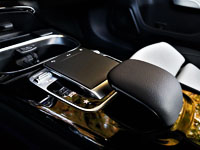
Together with everything already mentioned, this year’s A 220 comes well equipped with standard features such as LED headlamps, 17-inch alloys, brushed or pinstriped aluminum interior inlays, pushbutton start/stop, MBUX infotainment (although the base model’s display size is smaller than my tester’s at 7.0-inches for each of its two screens), a six-speaker audio system (that provided deep resonant bass tones along with nice mids and highs), a power-adjustable driver’s seat with memory, heated front seats, the panoramic sunroof mentioned earlier, forward collision warning with automatic emergency braking, plus a lot more.
You may have noticed more gear in the photos, this because my test model also came with $890 worth of Mountain Grey Metallic exterior paint; $500 of 18-inch five-spoke alloy wheels; a $3000 Premium package featuring proximity keyless access, power-folding mirrors, a bigger 10.25-inch digital instrument cluster and the same sized centre display featuring Apple CarPlay and Android Auto smartphone integration, voice control, induction charging, auto-dimming rear view and driver’s side mirrors, ambient lighting, a foot-activated powered trunk release, vehicle exit warning, and Blind Spot assist; a $1,600 Technology package that added multibeam LED headlights with Adaptive Highbeam Assist and Active Distance Assist; plus a $1,000 Navigation package including a GPS/nav system, live traffic, Mercedes’ Navigation Services, the augmented reality function noted before, a Connectivity package, and finally Traffic Sign Assist.

The long list of additions continue with a new (for 2020) $1,900 Intelligent Drive package boasting Active Brake Assist with Cross-Traffic Function, Active Emergency Stop Assist, Evasive Steering Assist, Enhanced Stop-and-Go, Active Lane Change Assist, Pre-Safe Plus, Map-Based Speed Adaptation (which uses the nav system info to adjust the A 220’s speed based on road conditions ahead before the driver can even see what’s coming), Active Lane Keeping Assist, an Advanced Driving Assistance package, Active Blind Spot Assist, Active Distance Assist Distronic, Active Steering Assist, Pre-Safe, and Active Speed Limit Assist; $900 Active Parking Assist; $475 satellite radio; plus black open-pore wood inlays for $250 (walnut inlays are available for the same price); all of which added $10,515 to the 2020 A 220’s previously noted $37,300 base price, making for an impressively equipped compact Mercedes at just $47,815 (plus freight and fees).
It was missing a lot of additional gear too, by the way, including a $1,500 Sport package or $2,000 Night package, $500 optional 19-inch alloys, a $250 heated Nappa leather steering wheel, a $1,500 head-up display unit, a $650 surround parking monitor, a $700 450-watt, 12-speaker Burmester surround audio system (which is quite the deal for this brand), a $300 garage door opener, a $450 powered front passenger’s seat with memory (the base model’s is manually operated), and $1,200 worth of cooled front seats (these new for this model year).
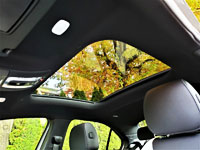
As impressive as the new A 220’s styling, cabin design, detailed execution and loads of features are, the brand’s century of heritage really comes through when out on the road. Despite only endowed with 188 horsepower and 221 lb-ft of torque, straight-line acceleration is quite strong and even more so when set to Sport mode, at which point shifts from the seven-speed dual-clutch automatic come quickly and precisely. The car’s now standard 4Matic all-wheel drive allowed all four of the 225/45R18 Michelins below to latch onto pavement simultaneously, resulting in sharp, immediate results when my right foot was pegged to the throttle, while the little sport sedan tracked brilliantly during fast-paced highway and curving byway excursions, even in rain-soaked conditions.
Standard shift paddles add some hands-on engagement that was really appreciated when pushing hard in Sport mode, but I also found them useful for short-shifting to save on fuel. I opted for Eco mode for such situations, which provided even smoother more relaxed shifts as well as fuel economy improvements. The A 220 is rated at 9.6 L/100km city, 7.1 highway and 8.5 combined, and while we’re talking efficiencies, last year’s front-wheel drive version didn’t make that much of a difference due to a claimed fuel economy rating of 9.7, 6.8 and 8.4 respectively, so therefore Mercedes’ choice to offer AWD as standard equipment won’t hamper your fuel budget.
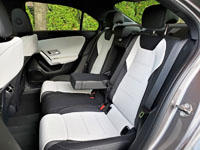
It was during my usual relaxed pace of driving, with a focus on saving fuel, that I really appreciated the A 220’s excellent ride quality, impressively smooth for this class of car, but then again it’s important for me to point out that it’s never soft and wallowy. In Germanic tradition its ride is firmer than rivals from Japan, although I couldn’t imagine anyone complaining about harshness. The A 220’s hushed ambiance makes it feel even more refined and luxurious, making it ideal for isolating noisy, bustling city streets as well as toning down the sound of wind on the open road.
I must say, if my own money was on the line in this entry-level luxury segment, I’d opt for the A 220 over its four-door subcompact premium rivals, as it scores high marks in all key categories. It looks stunning and offers up what I think is the nicest interior in the class, can be had with all the features I want and need, is great fun to drive when called upon yet provides all the pampering luxury I’d ever want, and is a fairly pragmatic choice too, at least with respect to four-door sedans.

This said I have yet to drive the new BMW 2 Series Gran Coupe, although its self-proclaimed four-door coupe body style won’t be able to offer up the same amount of rear seat headroom as the A 220, and the only other subcompact luxury competitors are the Audi A3, which has been on the market for seven-plus years with only a subtle mid-cycle makeover, plus the Acura ILX that’s just as long-in-the-tooth, although only last year it had a much more dramatic update. Still, the ILX is merely an old Honda Civic under the skin, albeit with a better powertrain and gearbox.
Whether opting for the new A 220 or one of the other cars mentioned in this review, I’d be sure to check them all out right here at CarCostCanada before heading to the dealership, mind you. Our 2020 Mercedes-Benz A-Class Canada Prices page was showing up to $750 in additional incentives at the time of writing, while the 2019 model (if still available) was available for up to $2,000 in additional incentives. Members can access information about manufacturer rebates, financing and leasing deals, or other incentives, and best of all is dealer invoice pricing that can save you thousands at the time of purchase. Find out how CarCostCanada works here, and make sure to download our free app at the Google Android Play Store or Apple App Store so you can access all this valuable info when you’re at the dealership.
Story and photo credits: Trevor Hofmann
Photo Editing: Karen Tuggay


